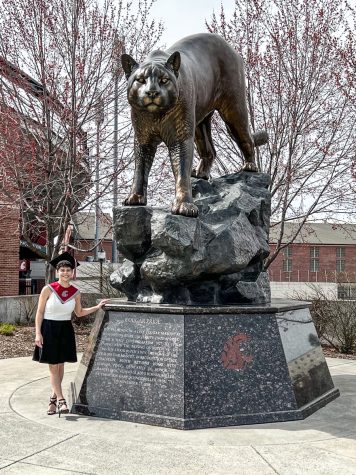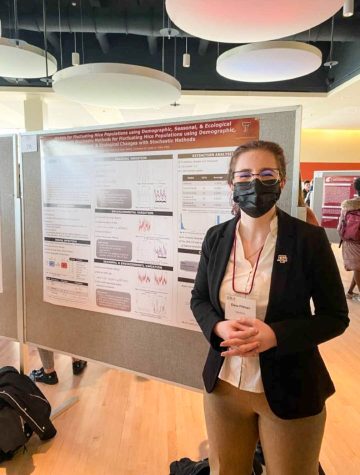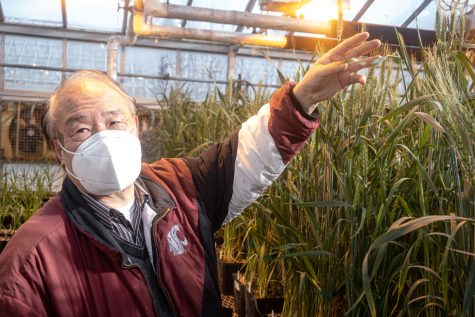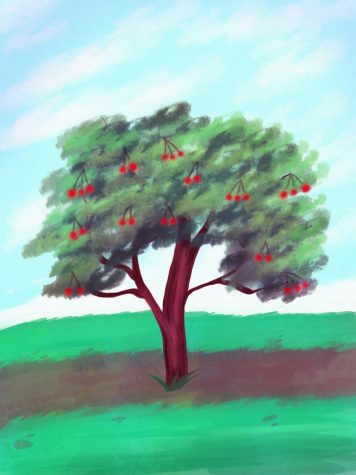These hooves weren’t made for walking
Disease does not spread to other species; no cure currently available to elk
Elk housed by the College of Veterinary Medicine are being tested for elk hoof disease transmission. The disease causes skin from the hoof to painfully slough off.
October 14, 2021
WSU researchers at the College of Veterinary Medicine recently discovered that elk hoof disease can be transmitted between elk that share the same soil.
Elk hoof disease causes sores to appear on elk feet, which can lead to their hooves painfully sloughing off, said Margaret Wild, lead researcher and professor of veterinary microbiology and pathology. The disease makes it difficult for the animals to move around.
“[The elk] lose body condition, and many of them eventually will die from the debilitation associated with the disease,” Wild said.
A group of six elk were studied in a new, controlled research facility on campus near the College of Veterinary Medicine building. During the research trial, hooves from infected wild elk were ground up and placed in mud within a pen of healthy elk.
This trial revealed the disease was transmitted to all four healthy elk. However, it was not transmitted to the two elk acting as the control group because they had autoclaved hooves, which are designed to kill the disease pathogens, Wild said.
In addition to the trial already performed, researchers will continue to concentrate on three areas of observational research: the disease pathogen, environment and host, she said.
“We are also trying to learn more about social aspects of the disease — what people know and how we can communicate better with people to share our results and gain information from their knowledge,” Wild said.
Steven Winter, WSU first-year graduate student, will be studying the research’s environmental element by looking at risk factors, such as weather, soil or vegetation that could contribute to the spread of the disease.
Winter said he will use computer modeling from the data collected during the trials to create a broader picture of how the disease is able to spread among elk.
“Once we learn that the disease can be indirectly transmitted between elk through contaminated soil through the trials … that will be used to inform the models,” Winter said.
Researchers will also observe pathogens involved with the disease, including a specific type called spiral-shaped Treponema bacteria, Wild said. One of the genes found in the bacteria will be sequenced to determine what species of bacteria are present.
“This will give us much more precise information about what bacteria are there,” she said.

But Treponema bacteria is difficult to study because it cannot be grown in a lab or cultured. Wild said a doctoral student will focus on learning how to culture the bacteria.
The research is still in its preliminary stages and will take place at least over the next five years, Wild said. More studies will occur once data has been collected.
“One thing we could do is house deer and elk together,” Wild said. “Once we get a good model, and we know that we can reproduce the disease in captivity, then we can do additional studies.”
Elk hoof disease appeared as an outbreak in southwest Washington in 2008. However, locals believe it was present long before then, Wild said.
The disease has since spread to other parts of Washington, Idaho, Oregon and California, she said.
The only species documented to be affected by the disease are elk, which primarily reside in the west, Wild said. At this time, it is unknown why the disease does not affect other species closely related to elk, like deer or antelope, even when they live side by side.
There is a similar disease that occurs in domestic cattle called hairy heel wart, she said.
“It is not clear if it is the same disease as elk hoof disease, but it’s quite similar,” Wild said.
There are not many viable treatment options at this time, she said. Foot baths are sometimes used in cattle with similar diseases, but the animals have to be treated every day, and it is somewhat effective.
“With free range elk, you are lucky if you even get your hands on them once,” she said.
Because the disease is transmissible, Wild said efforts should focus on disease management rather than treatment.
Transparency will also be important going forward, especially from people in public, like hunters, who may encounter the disease while in the wilderness, Winter said. Any amount of data will help research efforts.
The Washington State Legislature designated the College of Veterinary Medicine as the lead research institute for elk hoof disease, Wild said.

















